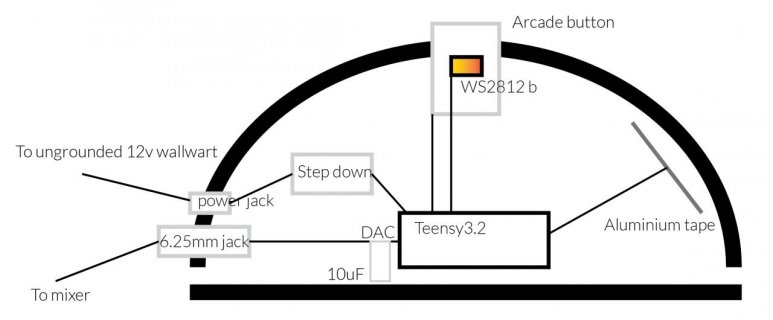Hey all,
I'm working on a musical instrument in which I'm using the Teensy 3.2's Touch pins. I'm having some problems though keeping it calibrated in electronically busy environments.
The Teensy pins are hooked up to 11 4x4cm squares of aluminium tape on the inside of a wooden bowl with about a 5mm wall thickness. The user then interacts with the device by touching or hovering over the bowl.
The Teensy is powered with a 12v switching mode going to a simple 4A DC step down module.
I'm using the DAC pin with a 10uF electrolytic capacitor to ground going to a 6.35mm jack output.
After calibration in an environment with few electronics, the instrument works fine, but when I move it to an electronically busy (next to speakers, amplifiers and other sound equipment) the calibration goes way off and isn't even stable after calibrating it.
I've noticed that when I touch the outer ring (ground) of the jack, that things seem to get stable, so I guess a grounding problem could be the culprit. Yet it is a bit impractical to run a separate wire to ground.
Is there a way to stabilize the touch pins on the Teensy, or should I be looking at other solutions?
Thanks!
I'm working on a musical instrument in which I'm using the Teensy 3.2's Touch pins. I'm having some problems though keeping it calibrated in electronically busy environments.
The Teensy pins are hooked up to 11 4x4cm squares of aluminium tape on the inside of a wooden bowl with about a 5mm wall thickness. The user then interacts with the device by touching or hovering over the bowl.
The Teensy is powered with a 12v switching mode going to a simple 4A DC step down module.
I'm using the DAC pin with a 10uF electrolytic capacitor to ground going to a 6.35mm jack output.
After calibration in an environment with few electronics, the instrument works fine, but when I move it to an electronically busy (next to speakers, amplifiers and other sound equipment) the calibration goes way off and isn't even stable after calibrating it.
I've noticed that when I touch the outer ring (ground) of the jack, that things seem to get stable, so I guess a grounding problem could be the culprit. Yet it is a bit impractical to run a separate wire to ground.
Is there a way to stabilize the touch pins on the Teensy, or should I be looking at other solutions?
Thanks!


